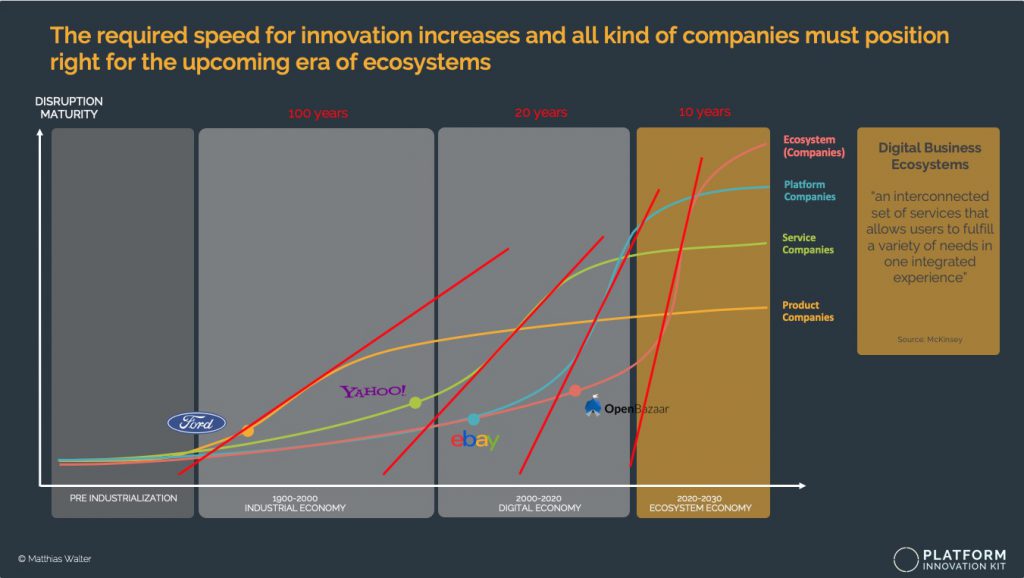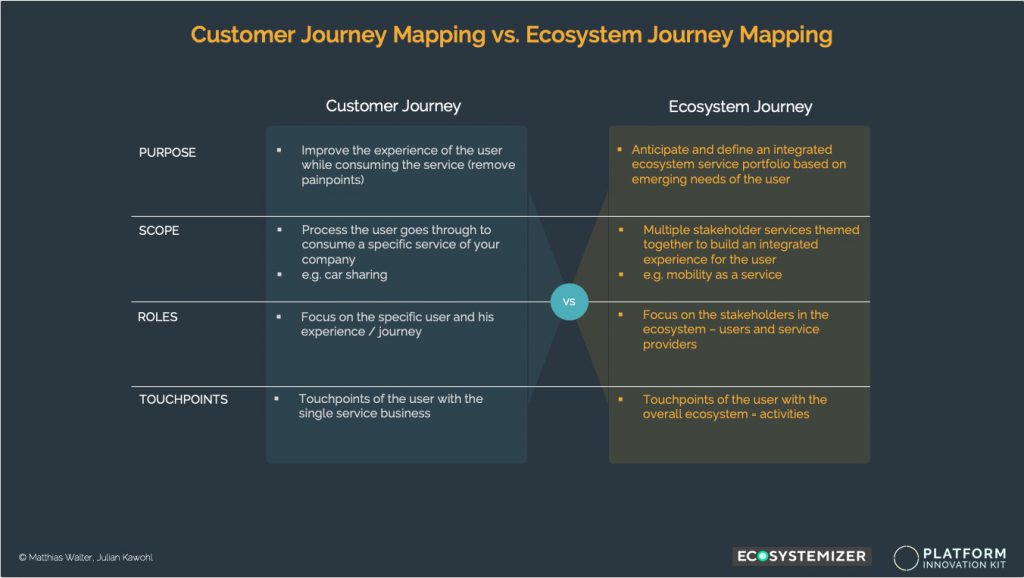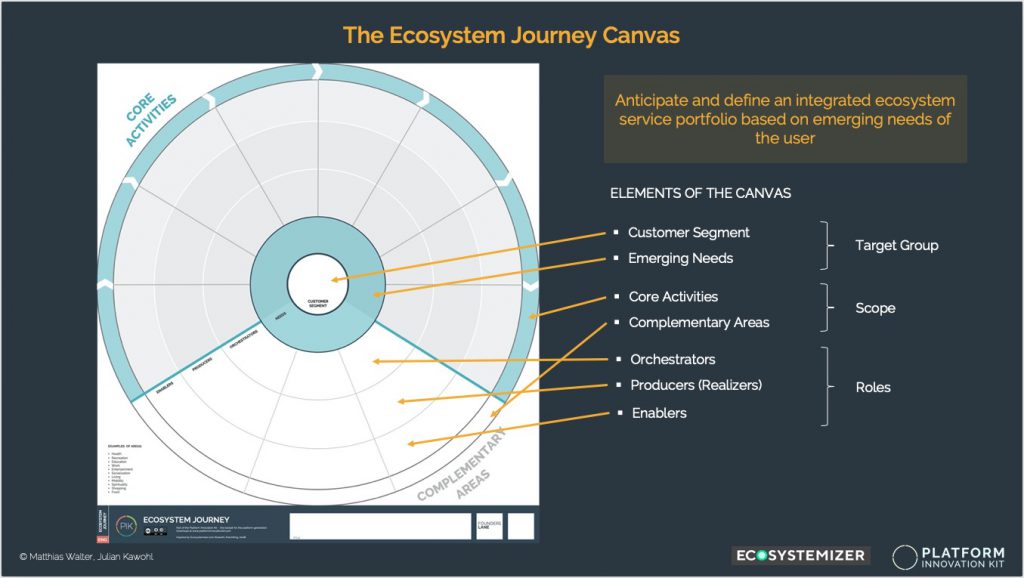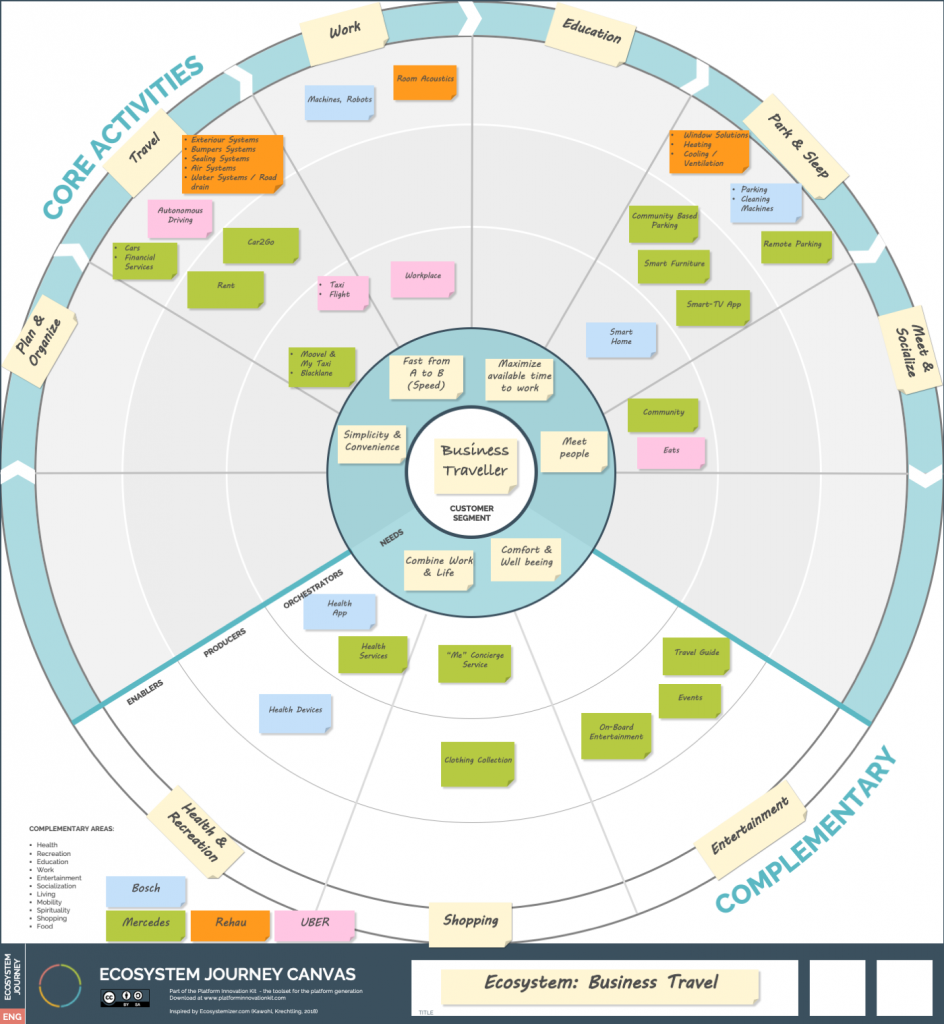Introducing the “Ecosystem Journey Canvas” as a new strategy tool to enable growth in the era of platforms and ecosystems.
Key Takeaways for the Reader
- Platforms currently disrupting value chains to become orchestrators — the big Unbundling
- Digital Business Ecosystems (DBE) are a new phase, where services belonging to a bigger theme will be bundled under one umbrella — the next bundling
- Therefore DBE will lead to industries without borders and the separation of B2C and B2B dissolves
- Traditional concepts related to the customer journey do not reflect the bigger picture of ecosystems and therefore need to be expanded on
- The Ecosystem Journey Canvas (EJC) is a strategy framework that provides structure and guidance for companies that sell innovation and growth opportunities through ecosystem collaborations
- Visual facilitation tool for innovation, growth and strategy leaders
- Download the canvas as part of the Platform Innovation Kit for free here
Intro
We all have examples of digital disruption across different industries. Giants such as Kodak, Nokia or Toys R Us or more recently the traditional German bicycle producer, Kettler, (inventor of the famous Kettcar.) Digital disruption is happening now and corporates in all sectors are struggling to compete in a digital economy, that is increasingly dominated by platforms and ecosystems. This is nothing new, but still we see more and more examples of companies crushing into bankruptcy, by not having the right strategy.
Therefore, we would like to present the Ecosystem Journey Canvas as a framework and tool to guide your company through the jungle of strategic options and help you to make better decisions to position you right in emerging ecosystem markets. In our field-tested research with practitioners we analyzed over 200 businesses and talked to more than 450 executives to identify best practices of digital leaders.
The “Ecosystem Journey Canvas” helps companies to:
- Follow a structured approach to define a winning ecosystem strategy
- Identify and prioritize innovation whitespaces and areas for future growth
- Define an aligned future offering portfolio
- Decide on build / buy / partner approaches
- Optimize resource allocation
The rising era of the Ecosystem Economy
Why are markets changing so dramatically and companies need to renew their business? The repeatedly reported reasons: management mistakes, too slow market adaption or bad strategies reveal only part of the answer.
Based on our interviews, there are 2 overarching factors driving disruption:
A) Raising expectations from end consumers to get more services conveniently bundled (Bundling of Services = the core aim of ecosystems — see for details definition below).
B) Value Chain Disruption through platforms leading to corporates being pushed upstream on the value chain, losing direct contact with consumers; facing shrinking margins for their products.
Accelerated by rising digitalisation, we also observe that the required speed for innovation increases. When we compare the current economic effects we are now at the border between the digital economy (dominated by platforms) and the ecosystem economy. (see chart below).



But what exactly is an ecosystem?
There are many definitions in different contexts out there, but our understanding aligns with the definition of McKinsey, where ecosystems are the umbrella of:
“an interconnected set of services that allows users to fulfil a variety of needs in one integrated experience“ (McKinsey and Company, 2018).
Meaning that the ecosystem era is the next phase of bundling after platforms shaped an era of “unbundling”.
Based on McKinsey research, $60 trillion in revenues by 2025 or roughly 30 percent of all global revenues will be mediated through ecosystems (McKinsey &Company, 2018). This estimation is highly consistent with the results of our discussions with practitioners.
But it is not only the pure size of market shifts, which make ecosystems so powerful. Moreover, they will change and disrupt the fundamental laws of doing business in two fundamental ways:
A) Industry boundaries fade and
B) Separation of B2C & B2B occurs.
From customer journey to Ecosystem journey
To give an example, let’s have a look at the mobility sector. Here the disruption and shift towards ecosystems is in full swing and can serve as an outlook of what will happen to other sectors as well.
Mobility platforms are the dominating orchestrator for many customer journeys. Looking at the different mobility & travel apps you have installed on your smartphone, 4 out of 5 are platforms like UBER, Tier, Airbnb, Booking.com & Co. They take a highly customer centric approach and position themselves between the consumer and the product / service company in the value chain.
This is great for the consumer and they quickly adopt to this increased convenience, but there is still potential. Consumers want even more convenience by getting more and more services bundled under one umbrella (platform). Their inner voice is asking: “How can I manage my whole trip with only one app”.
This example demonstrates how the traditional service journey is evolving to a broader multi-service journey — the ecosystem journey.



Disruption is getting faster
What is new in the ecosystem world is the intensity of how fast disruption happens. If the previously shown development becomes reality, we won’t have traditional sectors with the clear boundaries we know from today (i.e. pharma, automotive, retail etc.). Instead of these, we will have ecosystems — where companies from different sectors collaborate together for the best customer offerings. The first actions of companies to shape bigger ecosystems are already ongoing. Mostly driven by platforms, but also incumbent companies are very active. E.g. Mercedes and BMW recently started to collaborate to merge their mobility startups to one big mobility-as-a-service portfolio. If you don’t start now to think and act in ecosystems, you will fall further behind in the value chain.
Even B2B companies have to understand changing consumer behaviors to better anticipate changes to their business. To illustrate our argumentation, we take the example of the polymers producer and automotive supplier Rehau (German based company with around 3,5 Billion Euro revenue). In the last decades their main customer base were other producers from the furniture or automotive industry since their plastics were part of the surface of tables, kitchens and car interior. Today, because of the Internet-of-Things, the parts and products become more connected, intelligent and therefore new use cases with partners in the ecosystem are possible.
For instance, a table can now collect & share data and become a customer interface and putting Rehau closer to the user which is in this case the end consumer (the user). And this brings a previous supplier like Rehau in the position to change its business model in order to climb up the value chain for higher margins.
But this is easier said than done. Multiple strategic options have to be explored, evaluated and a decision made. To make this decision-making process easier we developed a new strategic framework.



The Tool — Ecosystem Journey Canvas
Based on our work with over 450 practitioners in the last 3 years to build & scale successful platform & ecosystem business models (see also www.ecosystemizer.com and www.platforminnovationkit.com), we evolved a new tool (canvas) as a framework to derive ecosystem strategies — the Ecosystem Journey Canvas.
Customer Journey vs. Ecosystem Journey
Marketers have developed the well-known customer journey in order to describe the most relevant customer touch points in a specific customer interaction or along the customer life cycle (see for example Cundari 2015).
In our Ecosystem Journey Canvas we take a broader viewpoint, rather than just one specific journey. We want to map out all major activities (attention points) which belong to the ecosystem from a customer perspective.
We call them Core Activities.
Purpose of the Canvas
The purpose of the Canvas is to provide a structured decision-making framework to
A) identify & define future playing fields (incl. whitespaces)
B) define your future role and offerings in the emerging ecosystem
C) prioritize and take decisions on buy / build / partner to maximize the benefits and chances to success
How it works — step-by-step guide
1. Define the Customer & Scope of Ecosystem
The starting point of any Ecosystem Strategy should be the definition of the scope. What is the ecosystem we want to have a look at? Without a clear understanding of the scope you will end up with endless discussions in management meetings.
Any scope definition starts with the customer — clearly define who is your customer segment you want to address and which core activities belong to the Ecosystem Journey.
In addition to that we have an extra space for so-called Complementary Activities on the outer ring on the bottom of the canvas. Here, we fill in complementary areas that are not core of the journey, but that are still relevant for the customer (segment). In this context, we refer for inspiration to the concept of the Ecosystem Strategy Map (Kawohl and Krechting, 2018), that includes 10 life areas in the ecosystem (along mobility that are living, health, consumption, spirituality, entertainment, education, work, recreation and socialize).
2. Emerging Customer Needs
The next layer around the center is about Emerging Customer Needs. Here you take an outside-in perspective and reflect on changing needs in the future. Typically this is based on solid trend analysis, design thinking exercises or customer interviews and defines what are important customer needs in the upcoming 3–5 years which will have a significant impact on how and what customers desire.
3. Stakeholder Mapping
After having defined the scope and emerging needs, it’s important to map key stakeholders of the ecosystems: you, competitors, new market entries etc. to understand the “who is who along the journey”.
To support the mapping we differentiate between three major roles a company can play (for further details see www.ecosystemizer.com):
Enabler — supporter of Realizer and Orchestrator by delivering technologies, content, products and services — e.g. Bosch
Realizer / Producer — provider of content, products and services — e.g. Volkswagen
Orchestrator — middleman of products and services via a platform — e.g. UBER
The three roles are considered by the 3 layers on the canvas. Here you can map the different players of the ecosystem including yourself and your offerings. Especially larger companies with a broad portfolio of offerings should map all offerings belonging to this specific ecosystem.



Example: Business Travelling in the Mobility Ecosystem
We would like to show the application of the Ecosystem Journey Canvas with an example of a business traveler within a mobility ecosystem.
Customer and Scope definition
We put the customer, the business traveler, in the center of the canvas and define the core and complementary activities belonging to a business trip.
Emerging Needs
In a next step, we identified some of the major needs that a business traveler faces during a multiday trip for his company. On the one hand, these are mainly efficiency needs such as maximizing available time to work and on the other hand convenience needs such as combining work and life. Since you have to find potential offerings for these needs, we recommend to focus on the top needs.
Stakeholder
In order to fill the Ecosystem Journey Canvas with life, we collect offerings for the core activities and the complementary areas and put them on the equivalent positionings (Orchestrator, Realizer/Producer or Enabler). In our case, we choose Rehau (which we already mentioned above), Mercedes and Uber as showcase examples for companies that could provide an offering for the business traveler. With that selection we demonstrate that ecosystem strategies are relevant for all companies, no matter size, history and positioning. Nevertheless, in our projects we often have just one company or business unit (and its ecosystem partners) in the horizon of observation.
Next Steps — Innovation Whitespaces & Ecosystem Strategies
The filled Ecosystem Journey Canvas shows the as-is situation of the three companies in the mobility ecosystem of a business traveler. Based on the identified emerging needs of the business traveler, you can now prioritize and identify whitespaces or strategic hotspots for a future positioning.
To be continued …
In part 2 of our series we will further explain & outline potential strategic moves you should explore and decide on.




